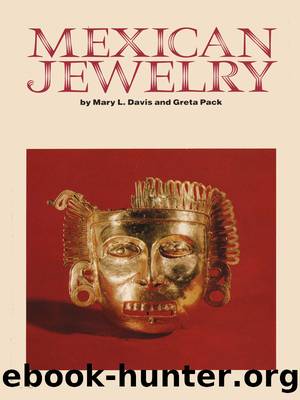Mexican Jewelry by Mary L. Davis

Author:Mary L. Davis
Language: eng
Format: epub
Tags: Mexican Jewelry
Publisher: University of Texas Press
Published: 2014-10-27T00:00:00+00:00
PLATE 78. Jewelry from Yucatán: a rosary of gold filigree and jet beads with a carved gold cross; a string of gold filigree beads.
PLATE 79. Alma Reed in the typical mestiza costume and the large gold rosary which is always part of the costume for fiestas. Miss Reed was a protagonista in a famous romance. She was engaged to Felipe Carillo Puerto, the governor of Yucatán, but while she was in New York preparing for the wedding her fiancé was killed in one of the struggles of the Mexican Revolution. Miss Reed has devoted her life to Mexico, and is the only living American woman to possess the governmentâs recognition for distinguished service, symbolized by the Aztec Eagle.
This part of the country is the home of amber jewelry, amber with silver or gold beads, pale amber earrings like the ones shown on Plate 55. In the market at San Cristóbal las Casas an old woman sold us little chunks of amber crudely carved in the shape of a heart and flowers to be tied on the babyâs wrist for luck. In Iguala they were selling little pieces of jet for the same purpose, and in Tehuantepec small alligator teeth mounted in gold.
Every part of the country where filigree is made claims to do the best work. Without having made a specialized study of the subject, we felt that the work from Chiapas seems to be the most inventive and varied in design, and the Oaxaca work the most elegant because of all the pearls. In Yucatán they use very fine wire which gives their work an extremely lacy appearance.
Of the filigree made in Yucatán the handsomest piece, and the best known, is a long rosary of filigree beads combined with coral or other stones, ending in a filigree cross of distinctive design. When the Yucatán women wear the festive mestiza costume, the rosary is always an important part of the costume. The little rosary on Plate 79 is from Yucatán and, while not the typical rosary, it is interesting for the delicacy of the hand carving.
The flower and butterflies on Plate 82 are of silver wire used ingeniously to produce the form and pattern. They are from a collection picked up in shops and markets in various towns and their provenance is not known to us.
Download
This site does not store any files on its server. We only index and link to content provided by other sites. Please contact the content providers to delete copyright contents if any and email us, we'll remove relevant links or contents immediately.
Technical Art History by Jehane Ragai(452)
Art, Science, and the Natural World in the Ancient Mediterranean, 300 BC to AD 100 by JOSHUA J. THOMAS(409)
Graphic Culture by Lerner Jillian;(396)
The Slavic Myths by Noah Charney(366)
Pollak's Arm by Hans von Trotha(338)
Treasuring the Gaze by Hanneke Grootenboer(336)
Simply Artificial Intelligence by Dorling Kindersley(335)
Sketchbook Confidential: Secrets from the private sketches of over 40 master artists by Editors of North Light Books(334)
The Art of Portrait Drawing by Cuong i(329)
Drawing for the Soul by Zoë Ingram(326)
Drawing Landscapes by Barrington Barber(317)
Mountain Manâs Field Guide to Grammar by Gary Spina(312)
The Art of Painting Sea Life in Watercolor by Maury Aaseng Hailey E. Herrera Louise De Masi and Ronald Pratt(308)
Portrait of a Woman by Bridget Quinn(298)
Anatomy for the Artist by Jennifer Crouch(291)
A text-book of the history of painting by Van Dyke John Charles 1856-1932(287)
Preparing Dinosaurs by Wylie Caitlin Donahue;(280)
Botanical Illustration by Valerie Price(278)
Egyptian art by Jean Capart(276)
